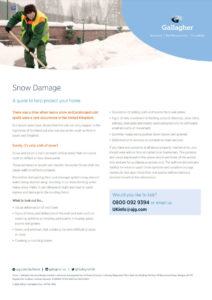A guide to help protect your home
There was a time when heavy snow and prolonged cold spells were a rare occurrence in the United Kingdom.
But recent years have shown that this can not only happen in the highlands of Scotland but also as far south as Kent in south east England.
Surely, it’s only a bit of snow?
Snow and ice on a roof can exert vertical loads that can cause roofs to deflect or bow downwards.
These extremes in weight can transfer horizontal forces that can cause walls to deflect outwards.
Blocked or damaged gutters and drainage systems may prevent water being drained away, resulting in ice dams forming when heavy snow melts. It can refreeze at night and lead to water ingress and damage to the building fabric.
What to look out for…
- Visual deformation of roof steel
- Signs of stress and deflection of the roof and walls such as cracking, splitting or twisting, particularly in trusses, joists, beams and girders
- Doors and windows that suddenly become difficult to open or close
- Creaking or cracking noises
- Separation of ceiling joists and beams from wall plates
- Signs of new movement in flashing around chimneys, door trims, ceilings, staircases and mastic seals designed only to withstand small amounts of movement
- Sprinkler heads being pushed down below ceiling levels
- Deformation to services or conduits to main services
If you have any concerns at all about property maintenance, you should seek advice from a trusted local tradesman.
The opinions and views expressed in the above article are those of the author only and are for guidance purposes only. The authors disclaim any liability for reliance upon those opinions and would encourage readers to rely upon more than one source before making a decision based on the information.
